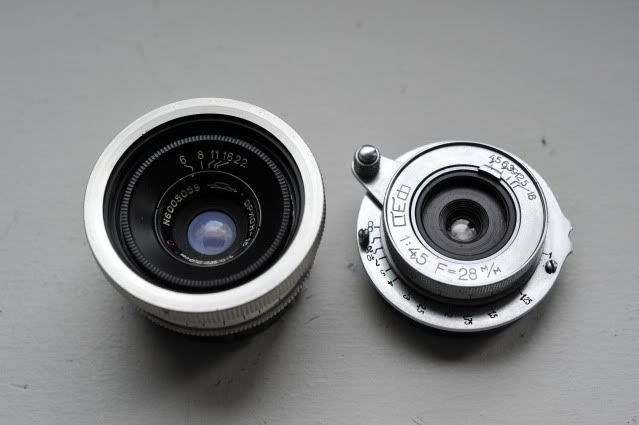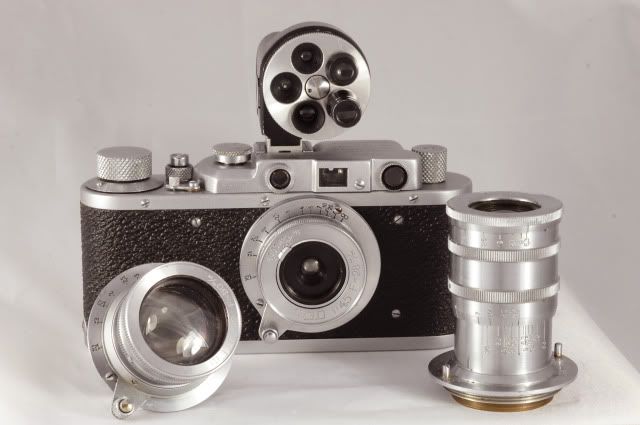johannielscom
Snorting silver salts
On the net I found a technical description of the 1938-produced FED 28mm 4.5 wide angle lens. I was astounded when reading its description. If ever there was proof of the Russian optical industry being able of much more than simply copying Leitz and Zeiss designs, this is it.
This is the lens it's all about:

And it indeed does look a lot like a Tessar design, or the Leitz Hektor 28mm 6.3 lens.
BUT: this lens has SIX elements, which are ALL air spaced. The front element is only SEVEN millimeters wide. The most extreme feat of engineering is the third element, which is ground to only SEVEN TENTHS of a millimeter thickness.
I was shocked.
I looked at the nail of my little finger: the third element was probably as thick as that, but MUCH smaller. And it had to be ground, placed and aligned properly.
I managed to find a lens diagram on USSRphoto.com but it's as tiny as the lens elements itself:

The third element from the right is the small peak of engineering.
As rumour goes, this lens is sharper than the Hektor and maybe even the Tessar.
There is a downside though: the lens almost always has to be collimated to the body it will be used on, since it's a pre-war FED lens. FED did not introduce standardization until after WWII, before then all lenses were made to fit bodies, like Leitz did before standardizing production. One could use the lens as a scale focused lens, but that would be a waste of the maximum speed of 4.5 I guess.
Now why did I bother to read up on this? Well, I bumped into one today and it was cheaper than that Tessar lookalike the Orion 28mm 6.3 lens. And as I'm the owner of a FED-S with 50/2.0 Summar clone and 100/6.3 tele, I figured it would be nice to have a third lens that belongs to the FED prewar system cameras.
My camera has been to Yuri at Fedka.com and I may have to send it over again to have this lens collimated to the body once more. Fingers crossed.
This is the lens it's all about:

And it indeed does look a lot like a Tessar design, or the Leitz Hektor 28mm 6.3 lens.
BUT: this lens has SIX elements, which are ALL air spaced. The front element is only SEVEN millimeters wide. The most extreme feat of engineering is the third element, which is ground to only SEVEN TENTHS of a millimeter thickness.
I was shocked.
I looked at the nail of my little finger: the third element was probably as thick as that, but MUCH smaller. And it had to be ground, placed and aligned properly.
I managed to find a lens diagram on USSRphoto.com but it's as tiny as the lens elements itself:

As rumour goes, this lens is sharper than the Hektor and maybe even the Tessar.
There is a downside though: the lens almost always has to be collimated to the body it will be used on, since it's a pre-war FED lens. FED did not introduce standardization until after WWII, before then all lenses were made to fit bodies, like Leitz did before standardizing production. One could use the lens as a scale focused lens, but that would be a waste of the maximum speed of 4.5 I guess.
Now why did I bother to read up on this? Well, I bumped into one today and it was cheaper than that Tessar lookalike the Orion 28mm 6.3 lens. And as I'm the owner of a FED-S with 50/2.0 Summar clone and 100/6.3 tele, I figured it would be nice to have a third lens that belongs to the FED prewar system cameras.
My camera has been to Yuri at Fedka.com and I may have to send it over again to have this lens collimated to the body once more. Fingers crossed.
Last edited:
Ranchu
Veteran
Cool lens! Best luck with it, looks promising.
V
varjag
Guest
Orion-15 is Topogon type, not Tessar. A very, very different design, very painful in manufacturing.
johannielscom
Snorting silver salts
Thanks Eugene, I rephrased to be more in line with what I really meant!
Costo Kim
Established
ferider, do you think nikkors from 50's are copies of FED of 1938? 
ferider
Veteran
I did wonder where the original design came from 
ferider
Veteran
How about the 28/3.5, Fred ? Who built the first double Gauss, 6 element wide ? Thanks !
rxmd
May contain traces of nut
Well, I bumped into one today and it was cheaper than that Tessar lookalike the Orion 28mm 6.3 lens.
No wonder, the Orion-28 is pretty rare already by itself and has the advantage of being useable on all sorts of LTM bodies. (The Orion is also an extremely cool lens, completely distortion-free by virtue of its symmetrical construction.)
Nice find either way, I've never seen one "in the flesh". Try to see (carefully) if it screws into an LTM body at all - that may depend on the thread pitch of the lens mount. If it screws in, have it collimated not to the body, but to the LTM standard, and you'll have a nice wideangle.
sevo
Fokutorendaburando
How about the 28/3.5, Fred ? Who built the first double Gauss, 6 element wide ? Thanks !
The Zeiss Planar dates back to 1896, and the very ultrawide Topogon was patented by Zeiss in 1933 - there have been progressively wider variants of the design made in between.
johannielscom
Snorting silver salts
No wonder, the Orion-28 is pretty rare already by itself and has the advantage of being useable on all sorts of LTM bodies. (The Orion is also an extremely cool lens, completely distortion-free by virtue of its symmetrical construction.)
Nice find either way, I've never seen one "in the flesh". Try to see (carefully) if it screws into an LTM body at all - that may depend on the thread pitch of the lens mount. If it screws in, have it collimated not to the body, but to the LTM standard, and you'll have a nice wideangle.
I would be truly amazed if it screwed in all the way, my FED 50/2.0 does not fit onto a Barnack like it should. Nor does the FED 100/6.3.
Anyway, I have a Canon 28/3.5 that does the wide angle job on Barnacks, the M2 and M3. So this one will be dedicated to the FED Komandyrski. Let's hope it fits 'right out of the box'!
mretina
Well-known
Can anyone post any pics? I located a copy, but looking for images on the web I could find only a set on flickr, that is anything but good.
Dez
Bodger Extraordinaire
The two generations of Russki 28's are very different in construction, and I wonder why the older FED design was not picked up after the war. I have had very good results with the Orion lens, but I have found the contrast of the FED to be very low. I suspect the problem is with my particular example, which is somewhat foggy. I'll have to get brave and take the tiny little thing to bits to clean it. Congratulations on getting the set of lenses for your FED S; it is not easy to find these things.


Cheers,
Dez


Cheers,
Dez
goamules
Well-known
Along with uncoated lenses having low contrast, the more air spaces, the lower the contrast also. This wide angle has a ton of them. But it surely would be a fun one to try. Nice little set you have. I had the 50/2 until last week when I sold it. But I'm keeping the 100/6.3, which is pretty contrasty.
outfitter
Well-known
The pre-war Fed had a M39x1 (metric) thread while the Leica has an M39x1 (English) thread. Fed didn't change to standard Leica thread until after the war
rxmd
May contain traces of nut
The pre-war Fed had a M39x1 (metric) thread while the Leica has an M39x1 (English) thread. Fed didn't change to standard Leica thread until after the war
Slight correction - the latter should be M39x26 tpi (threads per inch). Since there are 25.4 millimeters to an inch, the result is approximately 0.977 millimeters per thread on the Leica standard, vs. 1 mm on the pre-war FED, enough to make it jam after a turn or two.
I wonder whether it would make sense to make a custom Leica M adapter with a M39x1 thread, for pre-war FED lenses on modern bodies.
I've received Johan's 28/f4.5 lens now and will get the first roll with pictures from it and the 50/f2 later today, fingers crossed; maybe I can post two or three here if they are good enough
Grytpype
Well-known
Did FED (or Zorki) ever use a Leica thread? As far as I have been able to discover they were always 1mm pitch, though they did standardise at the 28.8mm register at some point.
As well as the different pitch, another factor liable to aggravate jamming if you screw an FSU lens into a Leica is that the metric thread is a 60° thread and the 26tpi Whitworth is a 55° thread.
As well as the different pitch, another factor liable to aggravate jamming if you screw an FSU lens into a Leica is that the metric thread is a 60° thread and the 26tpi Whitworth is a 55° thread.
Brian Legge
Veteran
So when can we see more shots from this lens? I'm curious what it can do - I've only seen images from someone who said their lens was very fogged.
rxmd
May contain traces of nut
So when can we see more shots from this lens? I'm curious what it can do - I've only seen images from someone who said their lens was very fogged.
Well I have a roll here that needs scanning, and the lens is not fogged. It is sharp, but shows bad flare, and I mean really bad. Will post a few shots as soon as I can.
raid
Dad Photographer
Show us soon some results. The lens design sounds interesting.
mkok
Member
I've find a good one....
One shot taken with Panasonic GF1, and soon some from rolls....
I hope you enjoy it, i think it is a surprising lens for the age, better than a lot of contemporary lenses, don't you?

One shot taken with Panasonic GF1, and soon some from rolls....
I hope you enjoy it, i think it is a surprising lens for the age, better than a lot of contemporary lenses, don't you?

Share:
-
This site uses cookies to help personalise content, tailor your experience and to keep you logged in if you register.
By continuing to use this site, you are consenting to our use of cookies.
